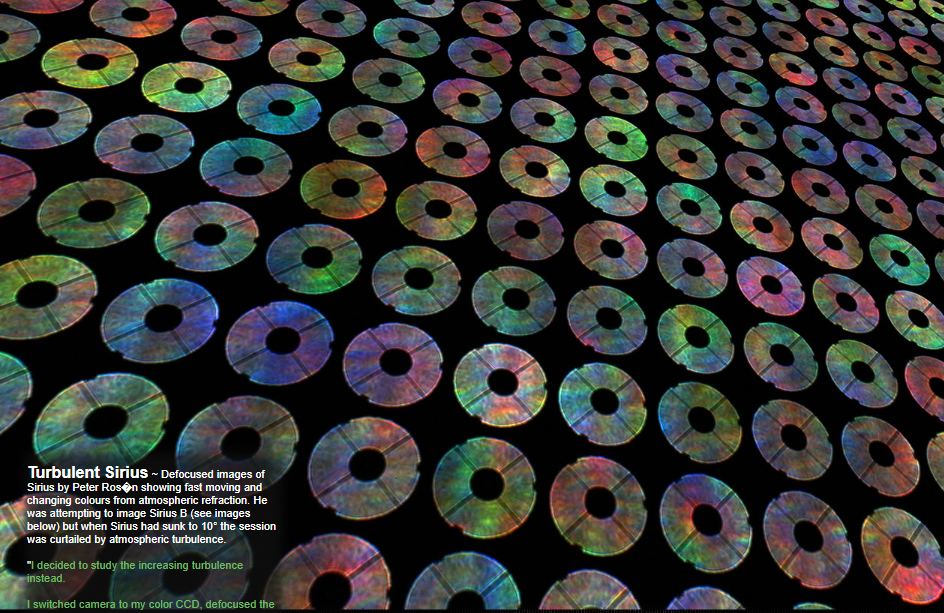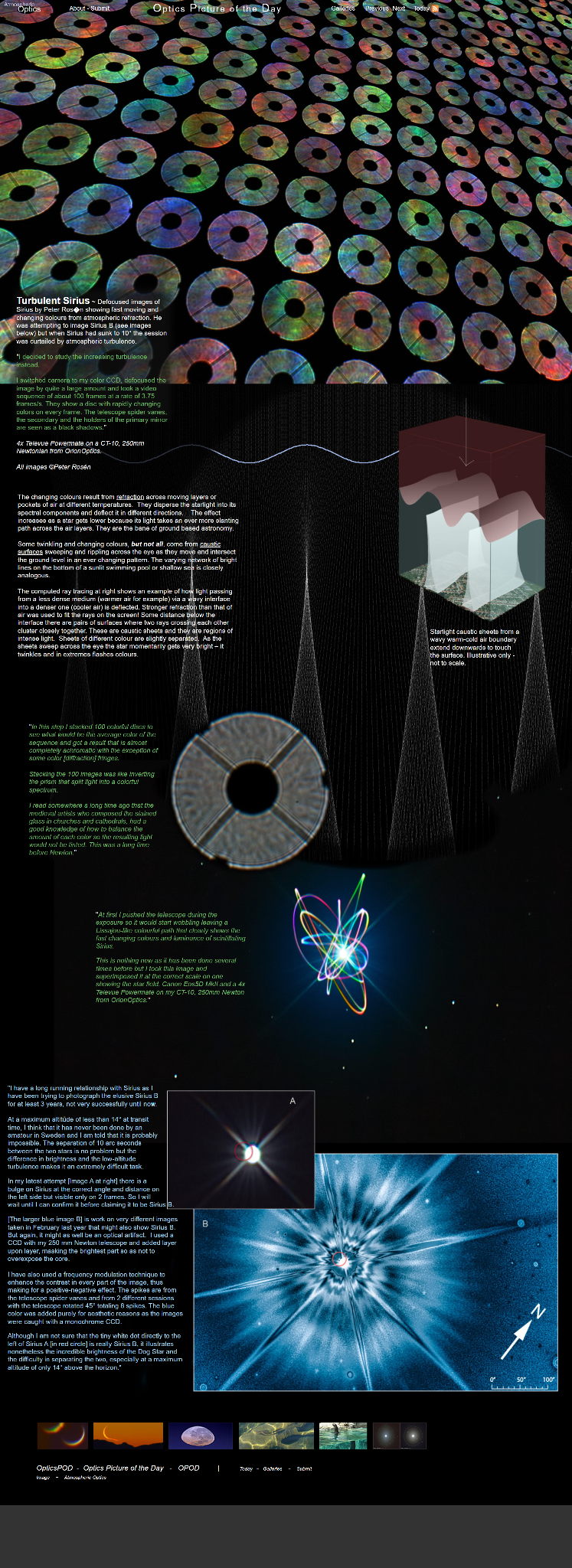OPOD - Sirius & Atmospheric Seeing
OPOD - Sirius & Atmospheric Seeing: A Fascinating Display of Turbulence and Refraction
Atmospheric turbulence and refraction can create captivating displays of light in the night sky. One such phenomenon is observed when viewing Sirius, the brightest star in the night sky. This article delves into the intricacies of atmospheric seeing and explores the mesmerizing effects it has on the appearance of Sirius.
When attempting to capture images of Sirius B, a companion star to Sirius, astrophotographer Peter Rosén encountered atmospheric turbulence that prevented him from achieving his original goal. However, he decided to embrace the opportunity to study the turbulent conditions instead. By defocusing the image of Sirius using a color CCD camera and capturing a video sequence of about 100 frames, Rosén was able to observe the fast-moving and ever-changing colors caused by atmospheric refraction.
The changing colors observed in the defocused images of Sirius are a result of the starlight being dispersed into its spectral components and deflected in different directions as it passes through moving layers or pockets of air at different temperatures. As a star gets lower in the sky, its light takes a more slanting path across the air layers, intensifying the effect of refraction. These atmospheric conditions, known as turbulence, pose challenges for ground-based astronomy.
Not all twinkling and color changes observed in stars are solely due to atmospheric refraction. Some of them can be attributed to caustic surfaces that sweep and ripple across the eye as they move and intersect with the ground level. An analogous example can be seen in the network of bright lines on the bottom of a sunlit swimming pool or shallow sea. These caustic surfaces contribute to the mesmerizing patterns of changing colors and luminance exhibited by stars like Sirius.
To better understand how light is deflected by varying air densities, a computed ray tracing simulation provides an example. The simulation demonstrates how light passing from a less dense medium, such as warmer air, to a denser one, such as cooler air, is deflected. The simulation even uses stronger refraction than that of air to illustrate the deflection of rays. It reveals the presence of caustic sheets, regions of intense light where pairs of rays cluster closely together, slightly separated by different colors. As these sheets sweep across the eye, stars momentarily appear brighter and exhibit twinkling and flashing colors.
Rosén also experimented with stacking multiple colorful discs to determine the average color of the sequence. The resulting image was almost completely achromatic, except for some color diffraction fringes. This process of stacking images is akin to inverting a prism that splits light into a colorful spectrum. Interestingly, Rosén draws a connection to medieval artists who composed stained glass windows in churches and cathedrals. These artists possessed knowledge of how to balance the amount of each color to ensure that the resulting light would not be tinted. This understanding predates Isaac Newton's work on the nature of light.
In his photographic endeavors, Rosén pushed the telescope during exposure to create a wobbling effect that captured the fast-changing colors and luminance of scintillating Sirius. By superimposing this image onto one showing the star field at the correct scale, he was able to showcase the dynamic nature of atmospheric seeing. The interplay between turbulence and refraction gives rise to these mesmerizing visual displays.
Rosén's quest to photograph Sirius B, the elusive companion star to Sirius, has been ongoing for several years. With a maximum altitude of less than 14° at transit time, capturing an image of Sirius B presents a significant challenge due to the difference in brightness between the two stars and the low-altitude turbulence. While Rosén has observed a bulge on Sirius that aligns with the expected position of Sirius B, further confirmation is required before claiming it as a successful capture. Nevertheless, his images offer a glimpse into the incredible brightness of Sirius and the difficulty in separating the two stars, particularly at such low altitudes.
In conclusion, atmospheric seeing and refraction play a significant role in shaping the appearance of stars like Sirius. Turbulence caused by moving layers of air at different temperatures leads to the dispersion and deflection of starlight, resulting in changing colors and twinkling effects. Caustic surfaces add another layer of complexity to these visual displays. Through the lens of astrophotographers like Peter Rosén, we gain a deeper appreciation for the intricate dance between light and the atmosphere, offering us glimpses into the wonders of the night sky.

Turbulent Sirius ~ Defocused images of Sirius by Peter Ros�n showing fast moving and changing colours from atmospheric refraction. He was attempting to image Sirius B (see images below) but when Sirius had sunk to 10° the session was curtailed by atmospheric turbulence.
"I decided to study the increasing turbulence instead.
I switched camera to my color CCD, defocused the image by quite a large amount and took a video sequence of about 100 frames at a rate of 3.75 frames/s. They show a disc with rapidly changing colors on every frame. The telescope spider vanes, the secondary and the holders of the primary mirror are seen as a black shadows."
4x Televue Powermate on a CT-10, 250mm Newtonian from OrionOptics.
All images ©Peter Rosén
The changing colours result from refraction across moving layers or pockets of air at different temperatures. They disperse the starlight into its spectral components and deflect it in different directions. The effect increases as a star gets lower because its light takes an ever more slanting path across the air layers. They are the bane of ground based astronomy.
Some twinkling and changing colours, but not all, come from caustic surfaces sweeping and rippling across the eye as they move and intersect the ground level in an ever changing pattern. The varying network of bright lines on the bottom of a sunlit swimming pool or shallow sea is closely analogous.
The computed ray tracing at right shows an example of how light passing from a less dense medium (warmer air for example) via a wavy interface into a denser one (cooler air) is deflected. Stronger refraction than that of air was used to fit the rays on the screen! Some distance below the interface there are pairs of surfaces where two rays crossing each other cluster closely together. These are caustic sheets and they are regions of intense light. Sheets of different colour are slightly separated. As the sheets sweep across the eye the star momentarily gets very bright – it twinkles and in extremes flashes colours.
"In this step I stacked 100 colorful discs to see what would be the average color of the sequence and got a result that is almost completely achromatic with the exception of some color .diffraction. fringes.
Stacking the 100 images was like inverting the prism that split light into a colorful spectrum.
I read somewhere a long time ago that the medieval artists who composed the stained glass in churches and cathedrals, had a good knowledge of how to balance the amount of each color so the resulting light would not be tinted. This was a long time before Newton."

"At first I pushed the telescope during the exposure so it would start wobbling leaving a Lissajou-like colourful path that clearly shows the fast changing colours and luminance of scintillating Sirius.
This is nothing new as it has been done several times before but I took this image and superimposed it at the correct scale on one showing the star field. Canon Eos5D MkII and a 4x Televue Powermate on my CT-10, 250mm Newton from OrionOptics."

"I have a long running relationship with Sirius as I have been trying to photograph the elusive Sirius B for at least 3 years, not very successfully until now.
At a maximum altitude of less than 14° at transit time, I think that it has never been done by an amateur in Sweden and I am told that it is probably impossible. The separation of 10 arc seconds between the two stars is no problem but the difference in brightness and the low-altitude turbulence makes it an extremely difficult task.
In my latest attempt .Image A at right. there is a bulge on Sirius at the correct angle and distance on the left side but visible only on 2 frames. So I will wait until I can confirm it before claiming it to be Sirius B.
.The larger blue image B. is work on very different images taken in February last year that might also show Sirius B. But again, it might as well be an optical artifact. I used a CCD with my 250 mm Newton telescope and added layer upon layer, masking the brightest part so as not to overexpose the core.
I have also used a frequency modulation technique to enhance the contrast in every part of the image, thus making for a positive-negative effect. The spikes are from the telescope spider vanes and from 2 different sessions with the telescope rotated 45° totaling 8 spikes. The blue color was added purely for aesthetic reasons as the images were caught with a monochrome CCD.
Although I am not sure that the tiny white dot directly to the left of Sirius A .in red circle. is really Sirius B, it illustrates nonetheless the incredible brightness of the Dog Star and the difficulty in separating the two, especially at a maximum altitude of only 14° above the horizon."
Note: this article has been automatically converted from the old site and may not appear as intended. You can find the original article here.
Reference Atmospheric Optics
If you use any of the definitions, information, or data presented on Atmospheric Optics, please copy the link or reference below to properly credit us as the reference source. Thank you!
-
<a href="https://atoptics.co.uk/blog/opod-sirius-atmospheric-seeing/">OPOD - Sirius & Atmospheric Seeing</a>
-
"OPOD - Sirius & Atmospheric Seeing". Atmospheric Optics. Accessed on November 26, 2024. https://atoptics.co.uk/blog/opod-sirius-atmospheric-seeing/.
-
"OPOD - Sirius & Atmospheric Seeing". Atmospheric Optics, https://atoptics.co.uk/blog/opod-sirius-atmospheric-seeing/. Accessed 26 November, 2024
-
OPOD - Sirius & Atmospheric Seeing. Atmospheric Optics. Retrieved from https://atoptics.co.uk/blog/opod-sirius-atmospheric-seeing/.